What do a varsity coach, a surfer, and an assistant professor have in common? They are part of the extraordinary group of student researchers at the Skeletal Observation Lab under the supervision of Dr. Mike Rainbow! Across Smith Engineering at Queen’s University, staff and faculty strive to build a strong community for students to thrive and feel a sense of belonging. For graduate students, in particular, the relationship they have with their supervisor and their colleagues in their research groups can be vital to establishing a strong community. Here at Mechanical and Materials Engineering (MME), our faculty members like Dr. Rainbow take this responsibility seriously and, even more importantly, they are thrilled to provide opportunities and space for students to grow and succeed.
We had the privilege of talking to some of Dr. Rainbow’s current and past students to hear firsthand about their graduate school experience at MME and the impact Dr. Rainbow’s approach to supervision has had on them.
Anja-Verena Behling is a third-year PhD student at the University of Queensland in Brisbane, Australia. Dr. Rainbow is her co-supervisor and so she has shared time between the institutions. Behling spent a little over 12 months here in Kingston working on foot biomechanics research across 2021 and 2022. Her recent paper "Chasing footprints in time - reframing our understanding of human foot function in the context of current evidence and emerging insights" was recently published in the prestigious journal Biological Reviews. It has been well received by clinicians and she was invited as a special guest on The Rehab Podiatrist Podcast to talk about her research of ankle and foot function.
Beyond her studies, Behling stays busy: “When I am not occupied with 3D foot bone images and analyses for my PhD, I take full advantage of the Aussie weather all year round and go running, surfing, and escaping the busy mind with yoga or sandy beach days. The only things I am missing in Australia are good pretzels (the German in me is sad) and the beauty of white Christmas with a frozen Lake Ontario in front of your nose.”
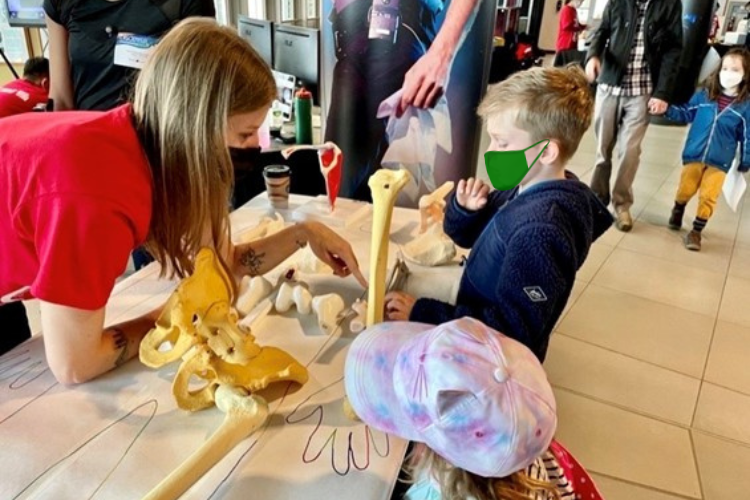
Above: Anja-Verena Behling introduces biomechanics to future Queen’s MME students at an outreach event in 2022.
Erin Lee is a fifth-year PhD student studying shoulder biomechanics in the Skeletal Observation Lab. Lee described how she became part of the research group: “I decided to pursue a direct-entry PhD after being introduced to the biomechanical stream during my undergrad degree in MME and having the opportunity to engage in research with Dr. Rainbow as a research assistant.”
In addition to the great paper she just published, which currently has more than 600 downloads, she is a Vanier scholar, and also won the Young Investigator award at the 2020 Canadian Society of Biomechanics meeting for her work on Shoulder Shape and Function.
Like Behling, Lee has no shortage of activities to accompany her time beyond her studies. Lee explained, “Outside of academics, I have a strong interest in improving the experiences of new and current graduate students. I serve as a [Smith Engineering] Graduate Student Ambassador as well as the graduate student representative on the [Smith Engineering] Strategic Plan Implementation Committee. I also have a passion for athletics. I recently joined the Queen’s Varsity Triathlon Team, and I am an assistant coach for the Queen’s Varsity Team.”
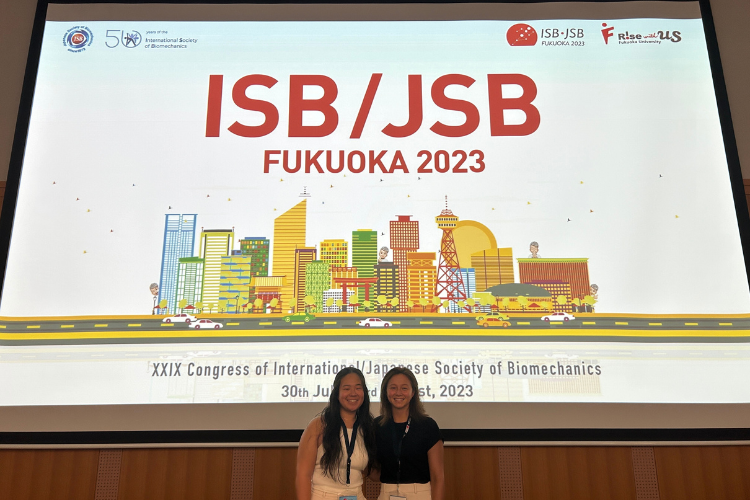
Above: Lab mates, Kayla Lee and Erin Lee (left to right), following their podium presentations at the International Society of Biomechanics in Fukuoka, Japan in August 2023.
Dr. Lauren Welte is a former PhD and undergraduate student of Dr. Rainbow’s, studying fundamental foot biomechanics during locomotion. After her years with us at MME she moved to the University of Wisconsin-Madison as a postdoctoral fellow. Dr. Welte was excited to announce, “I am about to start as an Assistant Professor at the University of Alberta (as of December 1, 2023).”
Her recent paper "Mobility of the human foot’s medial arch helps enable upright bipedal locomotion" in Frontiers in Bioengineering and Biotechnology changes our understanding of how the human foot functions. The paper was covered by 45 different news sites, including the Science News & Society issue from Today Headline. She was also interviewed on PodChatLive where she describes the Windlass Mechanism.
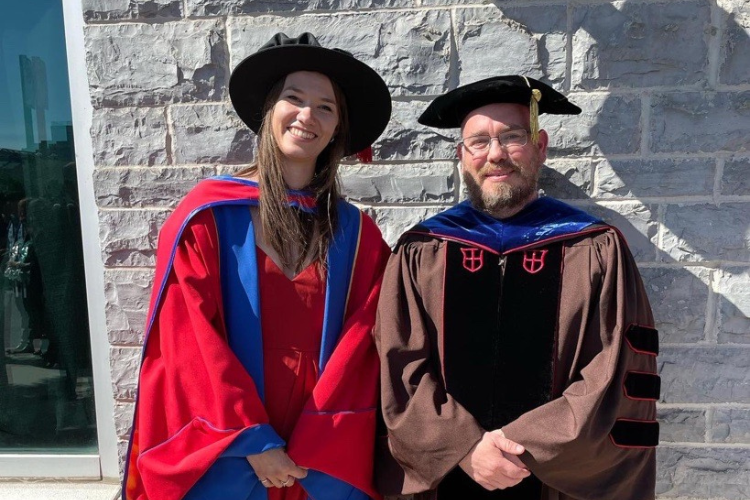
Above: Dr. Lauren Welte and Dr. Mike Rainbow at Dr. Welte’s PhD graduation.
The researchers at the Skeletal Observation Lab broadly focus on studying the musculoskeletal system for insights into joint health and function. It is not just their research that makes this lab special, it is the people and additional opportunities offered that create a warm and welcoming environment for students to thrive in.
For Dr. Rainbow, providing mentorship and support are some of the most important parts of his role as a supervisor and lab coordinator. He elaborated, “[my goal] in supervising students is to help them develop their skills by conducting thoughtful and rigorous research. I also aim to have them develop the confidence to challenge themselves, each other, and me, and to critically evaluate research in the field. Put differently, I want them to emerge from their studies here as strong scientists with their own network and ‘academic voice’. I believe these skills are relevant regardless of whether they pursue academia, industry, medicine, or all the above after they graduate. Importantly, we emphasize accomplishing this while maintaining life balance and prioritizing mental and physical health.”
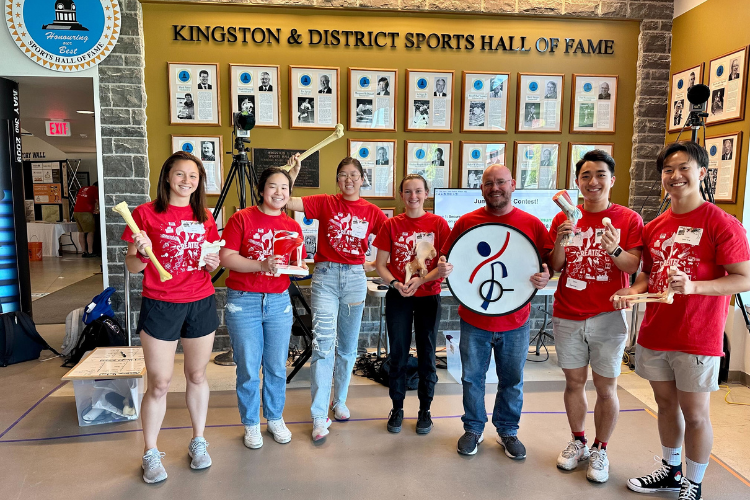
It is clear that Dr. Rainbow’s approach to supervision resonates strongly with his students as they each conveyed the positive impact he had on their research skills and the support he provided to developing their passion for the field.
Dr. Welte explained Dr. Rainbow’s impact beyond her time at MME, “Dr. Rainbow is an incredible mentor in many ways. One of his greatest traits is his excitement about research and curiosity about the world around us. Even after I left Queen’s, I still wanted to share with him every time I found something new and exciting in my work because I knew he would be just as excited as I was.”
Lee agreed and expounded on how his supervision is helpful beyond her studies: “Dr. Rainbow is exceptional in the one-on-one support he provides each of the members of the Skeletal Observation Lab. Throughout my PhD, Dr. Rainbow has provided consistent guidance but also promoted creative freedom in all aspects of our research. His mentorship is helping me to become a more independent thinker, effective communicator, and thoughtful researcher.”
Behling summarized, “My PhD and ability to do research would not be on the level it is at without Dr. Rainbow's guidance, support, and expertise.”
When describing his research group, Dr. Rainbow humbly stated, “From my view, we have a very positive and nurturing laboratory culture. Everyone contributes to this.”
The Skeletal Observation Lab is an example of how positive environments are made up of positive people. Every member actively fosters an inclusive and welcoming atmosphere, dedicated to supporting one another's research, pursuing their interests, and striving for their goals. Together, they've crafted an inclusive and welcoming environment that fuels academic excellence and personal growth.
When asked about Dr. Rainbow’s support of her research, Lee emphasized three cornerstones of her graduate experience: “mental health, work-life balance, and resilience.” She further explained, “To stay motivated with research and coursework, I've always found it essential to have interests and activities outside of academics. Our research group is fortunate that Dr. Rainbow recognizes this and encourages us to look after our mental health and pursue extracurricular activities. For me, that's been competing and coaching in swimming (and recently training for triathlon).”
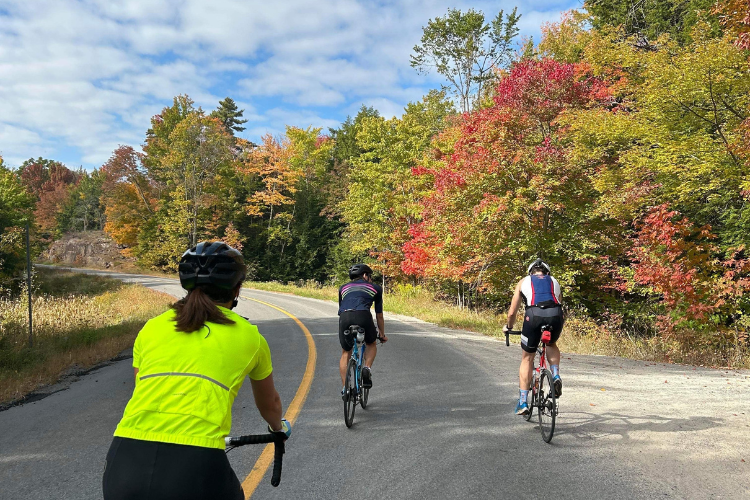
Above: Erin Lee biking with the Queen's triathlon team in October 2023.
Lee continued, “The inherent nature of research and graduate studies requires us to be resilient. I think, more often than we openly talk about, things do not go as planned. For example, equipment doesn't cooperate, papers get rejected, or external factors (e.g., COVID) prevent us from progressing. During those times, I'm thankful to have a supervisor who supports me and offers guidance on how to move forward, and a collegial research group where everyone looks out for each other. I'm also thankful to have something I am passionate about outside of my work, as it helps put everything into perspective. No matter what kind of day I had in the lab, going to the pool to swim or coach helps me to "reset" and get ready for the next day.”
Behling and Dr. Welte both described the significance of Dr. Rainbow’s person-first approach to supervision. Not only did this ensure they felt valued as part of the community of MME, but it also meant they were able to approach their passions with energy and commitment as healthy individuals.
“The most important part for me is that he always puts you as a person first and makes sure you are in the best place emotionally, mentally, and intellectually to conduct the best research you can do,” Behling expressed.
Dr. Welte agreed, “He also genuinely cares about his students and their experiences.”
“He does that by checking in with you regularly during 1:1 meetings, organizing lab group outings in professional (such as lab meetings, journal clubs, equity, diversity, inclusion, and belonging discussions) and personal settings (e.g., lab Olympics, grad club, and group hikes). He is genuinely interested in everyone's opinion,” Behling elaborated. “I have never met anyone, especially a professor, who embraces the various characters assembled in their lab group as holistically as Dr. Rainbow.”
This genuine care and support translated into professional opportunities Dr. Welte explained, “He enabled international collaborations and research abroad opportunities which allowed me to grow as a researcher and develop my own network early on. If I wanted to pursue a topic that was interesting to me, he allowed me the space to explore and experiment. I would not be the researcher I am today if it weren’t for him. Even though I haven’t worked at Queen’s for over two years, Dr. Rainbow is still one of the first people I talk to when I have professional questions and I continue to greatly value his advice and thoughtful perspectives.”
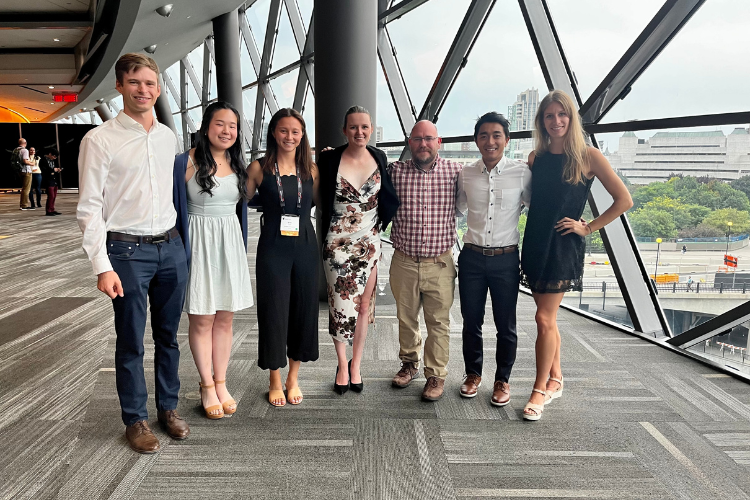
Above: the Skeletal Observation Lab at the North American Congress of Biomechanics (NACOB) in the summer of 2022.
In addition to the incredible research performed at the Skeletal Observation Lab, Dr. Rainbow consistently organizes trips and events that give students a chance to be away from the busyness of graduate school and allow them to focus on building community and connections with each other.
For Behling, the strong, positive interpersonal relationships fostered through team-building excursions remain an important part of her MME experience: “One of my best memories are the hiking trips with fellow grad students and Dr. Rainbow that he organized. It is an excellent example of how closely knit Dr. Rainbow's grad student group is despite having different interests, life experiences, and backgrounds. Surrounded by beautiful nature, usually leads to limitless chats about the philosophy of life, science, and the bigger picture in general, or simply to an extended discussion if a saxamaphone is a real instrument (FYI, it is not, but Homer Simpson made it a thing). It brings everyone together, which I think reflects strongly on the culture that is cultivated at Queen's MME department.”
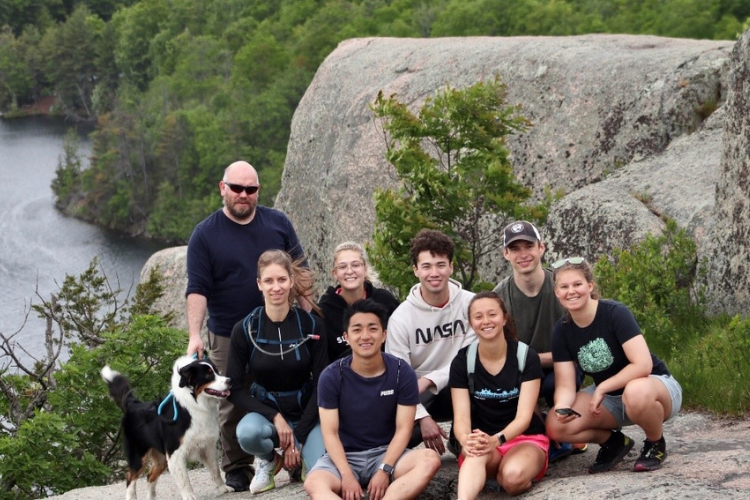
Above: the Skeletal Observation Lab team on a team-building hike in 2022.
Lee described the importance the opportunities to network and present at conferences have had on her overall student experience and development of relevant skills: “Since my summer undergraduate research, I've had unique opportunities to travel to national and international conferences thanks to support from Dr. Rainbow, the MME department, and [Smith Engineering] mobility awards. My work would not look the same if it weren't for the valuable conversations and inspiring talks that take place at these conferences. Conferences have inspired me to incorporate new and emerging methods into my research, see the "big picture" of my research projects, and meet other students and professors who have helped me develop personally and professionally. Presenting in front of large audiences has also given me a lot more confidence as a science communicator.”
Dr. Welte summed up her graduate school experience with Dr. Rainbow, “Community and lab culture was always very important to him. He liked to organize lab events, such as science outreach and hiking trips to bond together. While sometimes things didn’t go as smoothly as expected, just like in research, we leaned on each other and came up with solutions to solve the problems we faced. And of course, had some fun along the way!”
Our conversations with Dr. Rainbow's current and former students have provided valuable insights into their experiences within the Queen’s MME graduate program and the profound impact of Dr. Rainbow's supervisory and mentorship approach on their academic journeys.
Smith Engineering is dedicated to fostering a vibrant and inclusive community where both students and researchers can flourish and find a sense of belonging. This sense of community is especially crucial for graduate students, as it hinges on their relationships with their mentors and peers within their research groups. In the context of Mechanical and Materials Engineering, our faculty members, exemplified by Dr. Rainbow, embrace this responsibility wholeheartedly and are enthusiastic about creating an environment where students can thrive and achieve their potential.